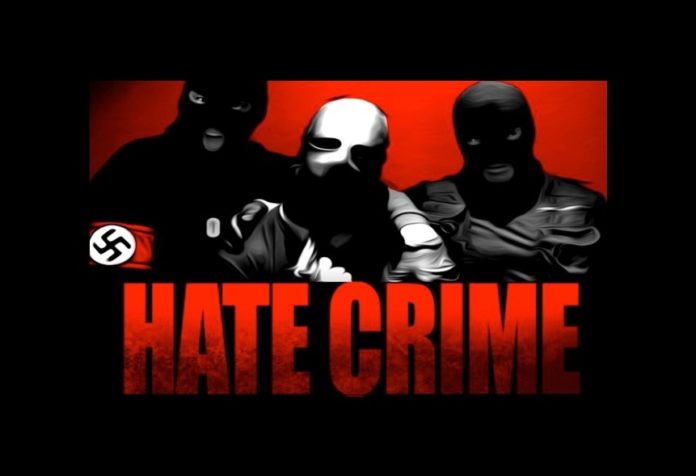
Written by: EV
On December 8th the FBI released the 2013 Hate-Crime Statistics, and while hate-crimes were on the rise in some states, such as Maryland, the report shows thatthey are down in areas such as Southern Nevada, and various other locations across the country. Although it would seem there has been a decrease in the number of hate-crimes reported nationally, some experts doubt the statistic’s accuracy. 
According to the FBI’s report:
- Law enforcement agencies reported 5,928 criminal incidents involving 6,933 offenses as being motivated by a bias toward a particular race, gender, gender identity, religion, disability, sexual orientation, or ethnicity in 2013.
- There were 5,922 single-bias incidents involving 7,230 victims. A percent distribution of victims by bias type showed that 49.3 percent of victims were targeted because of the offenders’ racial bias, 20.2 percent were victimized because of the offenders’ sexual-orientation bias, 16.9 percent were targeted because of the offenders’ religious bias, and 11.4 percent were victimized due to ethnicity bias. Victims targeted because of the offenders’ bias against disabilities accounted for 1.4 percent of victims of single-bias incidents; gender identity, 0.5 percent; and gender, 0.4 percent.
- Of the 5,814 known offenders, 52.4 percent were white, and 24.3 percent were black or African American. The race was unknown for 14.8 percent. Other races accounted for the remaining known offenders: 0.8 percent were American Indian or Alaska Native; 0.7 percent were Asian; 0.1 percent were Native Hawaiian or other Pacific Islander; and 7.0 percent were of a group of multiple races.
View full report here:
(http://www.deepcor.com/justice/2014/12/9/press-release-fbi-releases-2013-hate-crime-statistics)
Nationwide, hate-crimes appear to be down by 10% compared to 2012, however experts warn that there are a few factors that should be taken into consideration.
- Hate-crimes can be hard to define.
The FBI and lawmakers define hate-crimes differently. The FBI classifies any traditional offense, such as murder, arson, or vandalism, as a hate-crime if there is the added element of bias. Lawmakers define them as a “criminal offense against a person or property motivated in whole or in part by an offender’s bias against a race, religion, disability, ethnic origin, or sexual orientation.”
According to civil rights attorney, Allen Lichtenstein, hate-crimes are only recognized in the most obvious instances. A white-supremacist, for example, would probably have to brag publicly about targeting someone of another race in order to get caught.
“I’ve always been a bit concerned by the idea that something automatically is going to be called a hate-crime or something is not going to be called a hate-crime.” A better option would be to adopt “a more holistic, case-by-case analysis and consider what the mitigating factors are. I don’t know that putting it into a statutory form really is that helpful,” Lichtenstein stated.
- Hate-crimes are hard to prove.
Because most hate-crimes are mixed with other forms of criminal activity, like robbery, it’s hard for investigators and prosecutors to define the criminal’s true motives. It’s easy for the criminal to lie and say the crime was purely motivated by the robbery itself rather than admitting they targeted their victim based on their race, sex, sexual orientation, or handicap. Even if the criminal does seem to focus on one particular race or ethnic group, it’s hard to prove that it is bias.
Another problem is that in many states, hate-crimes aren’t necessarily treated any different. Taking Nevada for instance, crimes that have been proven as bias come with “enhancements”. This should, theoretically, upgrade the consequences of the crime, however the law only requires that the victims be compensated for monetary damages, which they most likely would have anyway. The question raised for law enforcement is, “Why take the time to prove something is a hate-crime when it really doesn’t make a difference?”
- Statistics for hate-crimes aren’t consistent.
Law enforcement agencies across the nation have begun to take less interest in providing annual statistics to the FBI. According to Mark Potok of the Southern Poverty Center, the number of agencies that have reported data to the FBI in the past have plummeted to 79%. In 2009, the Federal Law Enforcement Training Center ended its hate-crime programs, and the Southern Poverty Law Center ended a program in 2008 that taught law enforcement officials to recognize crimes involving bias.
“This apparent lack of interest and focus on hate crimes is worrying,” Potok stated.
He adds that more than half of all hate-crimes aren’t reported to police, and the majority of those that are reported tend to be categorized as other kinds of crimes. He claims that there are in fact 25 to 40 times more hate-crimes in the U.S. than the FBI is made aware of.
________________________________________________________________________________________-
Sources:
Contributor. Deepcor. Dec 9, 2014. (http://www.deepcor.com/justice/2014/12/9/press-release-fbi-releases-2013-hate-crime-statistics)
Federal Bureau of Investigation. Dec 8, 2014. (http://www.fbi.gov/news/pressrel/press-releases/fbi-releases-2013-hate-crime-statistics)
Ley, Ana. Las Vegas Sun. Dec 28, 2014. (http://lasvegassun.com/news/2014/dec/28/hate-crimes-down-stat-can-be-deceiving/)
Rector, Kevin. Baltimore Sun. Dec 12, 2014. (http://www.baltimoresun.com/features/gay-in-maryland/gay-matters/bs-gm-fbi-statistics-show-jump-in-hate-crimes-in-maryland-in-2013-20141212-story.html)





will want to join.
Here is a list of hacked accounts: [*]
[* removed: link]
Use another file sharing system, with no advertisements, or scam offers, thanks for your comment.